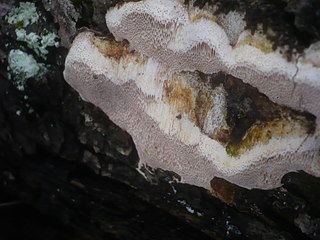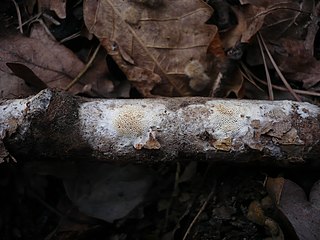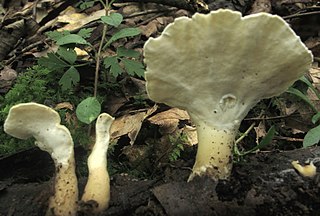Related Research Articles
Abundisporus is a small genus of poroid fungi currently with seven recognized species. They differ from other polypores in having coloured rather than hyaline spores.

Perenniporia is a cosmopolitan genus of bracket-forming or crust-like polypores in the family Polyporaceae. They are dimitic or trimitic with smooth, thick-walled basidiospores and cause a white rot in affected wood.

Phanerochaete is a genus of crust fungi in the family Phanerochaetaceae.

The Meruliaceae are a family of fungi in the order Polyporales. According to a 2008 estimate, the family contains 47 genera and 420 species. As of April 2018, Index Fungorum accepts 645 species in the family.

The Phanerochaetaceae are a family of mostly crust fungi in the order Polyporales.

The Xenasmataceae are a family of crust fungi in the order Polyporales. The family was circumscribed in 1966 by German mycologist Franz Oberwinkler with Xenasma as the type genus. As of April 2018, Index Fungorum accepts 28 species in the family. Xenasmataceae fungi grow as saprobes on fallen wood and are known primarily from temperate areas.

Auriporia is a small genus of four species of poroid fungi in the family Fomitopsidaceae.

Phlebia is a genus of mostly crust fungi in the family Meruliaceae. The genus has a widespread distribution. Phlebia species cause white rot.

Dacryobolus is a genus of crust fungi in the family Fomitopsidaceae. Elias Fries circumscribed the genus in 1849 with Dacryobolus sudans as the type species. Dacryobolus are wood-decay fungi that cause a brown rot.

Ceriporiopsis is a genus of fungi in the family Phanerochaetaceae. The genus is widely distributed, and, according to a 2008 estimate, contains about 25 species. Ceriporiopsis was circumscribed in 1963 by Polish mycologist Stanislaw Domanski. The genus is a wastebasket taxon, containing "species that share common macroscopic and microscopic characteristics, but are not necessarily related." Ceriporiopsis species are crust fungi that cause a white rot. They have a monomitic hyphal system, containing only generative hyphae, and these hyphae have clamp connections.

Hydnophlebia is a genus of five species of toothed crust fungi in the family Meruliaceae. All species are wood-decay fungi that cause a white rot.

Hyphoderma is a genus of crust fungi in the family Meruliaceae. It was circumscribed by German botanist Karl Friedrich Wilhelm Wallroth in 1833.

Steccherinum is a widely distributed genus of toothed crust fungi in the family Steccherinaceae.
Uncobasidium is a genus of two species of crust fungi in the family Meruliaceae. The genus was circumscribed by mycologists Kurt Hjorstam and Leif Ryvarden in 1978 with the European fungus U. luteolum as the type species. The South American species U. roseocremeum was added to the genus in 2012. The distinguishing feature of Uncobasidium is the basal hook in the basidium.

Dentocorticium is a genus of six species of poroid fungi in the family Polyporaceae. The genus was revised in 2018, with several new species added and some older species transferred to other genera, based on phylogenetic analyses.

Hapalopilus is a genus of poroid fungi in the family Polyporaceae. The genus is widely distributed. The generic name combines the Ancient Greek words ἁπαλός ("tender") and πιλος ("cap"). Hapalopilus was circumscribed by Finnish mycologist Petter Adolf Karsten in 1881.

Lopharia is a genus of fungi in the family Polyporaceae. The genus was circumscribed by Károly Kalchbrenner and Peter MacOwan in 1881.

Tyromyces is a genus of poroid fungi in the family Polyporaceae. It was circumscribed by mycologist Petter Karsten in 1881. The type species is the widely distributed Tyromyces chioneus, commonly known as the white cheese polypore. The phylogenetic position of Tyromyces within the Polyporales is uncertain, but it appears that it does not belong to the "core polyporoid clade". Tyromyces is polyphyletic as it is currently circumscribed, and has been described as "a dumping place for monomitic white-rot species with thin-walled spores."

Loweomyces fractipes is a species of poroid fungus in the family Steccherinaceae, and the type species of the genus Loweomyces. It is a widely distributed species, found in North America, Europe, Central America, South America, and Korea.
Cerocorticium molle is a species of crust fungus in the family Meruliaceae.
References
- ↑ Hennings, P. (1900). "Fungi monsunenses". Monsunia. 1: 137–174.
- 1 2 Jülich, W. (1975). "On Cerocorticium Henn., a genus described from Java". Persoonia. 8 (2): 217–220.
- ↑ "GSD Species Synonymy: Cerocorticium molle (Berk. & M.A. Curtis) Jülich". Species Fungorum. Kew Mycology. Retrieved 17 April 2018.
- ↑ Kirk, P.M. (ed.). "Species Fungorum (version 28th March 2018). In: Species 2000 & ITIS Catalogue of Life" . Retrieved 17 April 2018.
- ↑ Tellería, M.T. (1985). "De Aphyllophoralibus in Hispania provenientibus ordinati commentarii, III" (PDF). Anales del Jardín Botánico de Madrid (in Spanish). 42 (1): 49–60.
- ↑ Manjón, José Luis; Moreno, Gabriel (1984). "Cerocorticium canariensis sp. nov. (corticiaceae)". Botánica Macaronésica (in Spanish) (10): 27–32.
- 1 2 3 Jülich, W.; Stalpers, J.A. (1980). "The resupinate non-poroid Aphyllophorales of the temperate northern hemisphere". Verhandelingen Koninklijke Nederlandse Akademie van Wetenschappen Afdeling Natuurkunde. 74: 71–72.